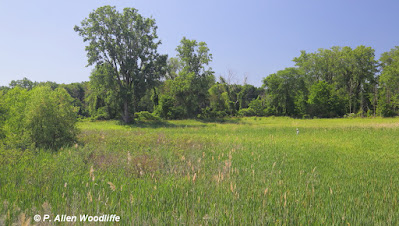Feb 2 is well-known for being Groundhog day. But is it really that important of a day to recognize? Will whether the groundhog sees its shadow or not, really be an accurate forecast of what is ahead for the remainder of winter?
I rather doubt it.
Perhaps the best thing about the attention given to groundhog day is that it provides us something to talk about during this normally long period of winter, when many are patiently waiting for spring!
Perhaps a much more important day on Feb 2 is the recognition of it being World Wetlands Day. Wetlands include coastal marshes, flooded forests, wet prairies, bogs, peatlands, etc. Wetlands are some of the most important elements of nature for so many reasons. For example they are indirectly the source of our drinking water. They harbour thousands of native species, both plant and animal, many of which are declining and at risk. They prevent flooding. They filter out sediment and pollutants from entering the rivers and lakes. They store carbon.
Canada is home to about 70% of the world's freshwater wetlands. We have been blessed far more than we realize, yet wetlands are constantly under threat of increased pollution and loss. They are being invaded by aggressive non-native flora and fauna. They are an easy target for conversion to some other purpose, including agriculture/commercial/industrial/residential development.
This first photo shows what a normal creek system looks like.
This next photo shows the same creek system, from the same spot, during a high water flood event only 5 days earlier, due to the heavily drained/tiled lands upstream.
This next photo show the invasion of non-native Phragmites into a high quality wetland along Lake St. Clair.
Exploring accessible wetland areas are immensely important for a person's mental and physical well being. For example watching a sunrise or sunset is generally a healthy event for a persons mental health, but when viewing it in a wetland setting increases its value.
 | ||
| Mitchell's Bay North Shore Trail sunset |
 |
| Chenal Ecarte sunset, north end of Bear Line |
 |
| Sunrise from Erieau, looking towards Rondeau Bay |
The greatest amount of freshwater wetlands in Canada are in the far north. In Ontario this includes the Hudson Bay Lowlands as shown by these next two photos taken while I was on a wildlife survey project at Polar Bear Provincial Park in the early 1990s.
At the opposite end of the province is Fish Point Provincial Nature Reserve at the southern tip of Pelee Island, with a small but quite functional and important wetland.
And in between, are many wetlands that feature that Canadian icon, the Canadian Beaver.
The central parts of Ontario are well endowed with small lake/wetland complexes.
 |
| North of Huntsville |
Other wetlands feature wildlife such as the Common Gallinule, a species easily heard, but not often seen.
Rare species such as orchids occur in quality wetlands. This next photo shows a person (centre right) involved in a survey for the endangered Eastern Prairie White-fringed Orchid at a wetland in Chatham-Kent.....
 |
| Eastern Prairie White-fringed Orchid |
 |
| Bickford Oak Woods Conservation Reserve |
 |
| Rondeau Prov Park |
 |
| St. Clair NWA |
 |
| St. Clair NWA |
 | |||
| Rondeau |
Let's give wetlands their due!!!
If you would like to subscribe, or unsubscribe, to Nature Nuggets, please send an email to: prairietramper@gmail.com













Lovely photos and content Allen. Love and blessings, Paula.
ReplyDeleteThank-you Paula....much appreciated!
DeleteHi Allen! Wetlands truly are amazingly beautiful and complex ecosystems. It is sad to think about the amount of wetland area that has been lost in Southern Ontario. Clearly the effects of low wetland cover can be seen with the flooding events that fill ditches, streets, and fields because the water is moved so quickly off the land.
ReplyDeleteOn another note, out of curiosity, was there any results from that survey for Eastern prairie fringed orchids?
Also on the note of wetlands, do you know of any bogs in the area other than Sifton Bog in East London? I cannot recall if it was a post you made about a bog in Huron County?
Hi Aaron....you are quite right regarding the loss of wetlands...so sad, but it seems it is the way things are these days. The small bits and pieces of wetland that are assembled by some well-meaning projects pale in comparison to how quickly high quality wetlands are being lost.
DeleteRegarding the orchid survey: the results vary from year to year, partly due to the variable water levels. But there are usually at least some found every year at this particular spot.
Regarding bogs: Sifton is the closest to Chatham-Kent as far as I am aware. I might have mentioned in a previous post about one that I had the pleasure of exploring in Huron Co a number of years ago, called Blind Lake Bog. Certainly a fascinating place, and when one wanders around it, it is hard to believe it is in southern Ontario.